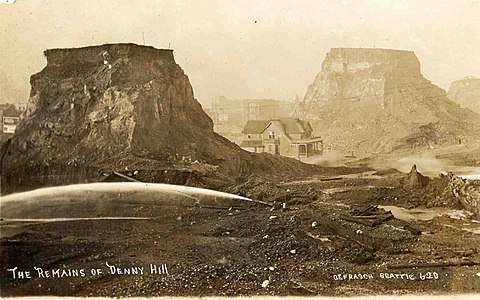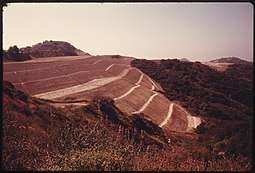Grading (earthworks)
Grading in civil engineering and landscape architectural construction is the work of ensuring a level base, or one with a specified slope,[1] for a construction work such as a foundation, the base course for a road or a railway, or landscape and garden improvements, or surface drainage. The earthworks created for such a purpose are often called the sub-grade or finished contouring (see diagram).

Regrading


Regrading is the process of grading for raising and/or lowering the levels of land. Such a project can also be referred to as a regrade.
Regrading may be done on a small scale (as in preparation of a house site)[3] or on quite a large scale (as in major reconfiguration of the terrain of a city, such as the Denny Regrade in Seattle).[2]
Regrading is typically performed to make land more level (flatter), in which case it is sometimes called levelling.[4]) Levelling can have the consequence of making other nearby slopes steeper, and potentially unstable or prone to erosion.
Transportation
In the case of gravel roads and earthworks for certain purposes, grading forms not just the base but the cover and surface of the finished construction, and is often called finished grade.
Process

It is often done using heavy machinery like bulldozers and excavators to roughly prepare an area and then using a grader for a finer finish.
Environmental design
In the environmental design professions grading and regrading are a specifications and construction component in landscape design, landscape architecture, and architecture projects. It is used for buildings or outdoor amenities regarding foundations and footings, slope terracing and stabilizing, aesthetic contouring, and directing surface runoff drainage of stormwater and domestic/irrigation runoff flows.
Purposes
Reasons for regrading include:
Consequences
Potential problems and consequences from regrading include:
- Soil and/or slope instability
- Terrain prone to erosion
- Ecological impacts, habitat destruction, terrestrial and/or aquatic biological losses.[3]
- Drainage problems (surface and/or subsurface flow) for areas not considered in the regrading plan.[6]
- Loss of aesthetic natural landscape topography and/or historical cultural landscapes.
See also
- Cut (earthmoving)
- Cut-and-cover
- Cut and fill
- Fill dirt
- Grade (slope) (civil engineering and geographical term)
- Regrading
- Slope (mathematical term)
- Subgrade
- Trench
References
- "Grade.1.". def. 2. Whitney, William Dwight, and Benjamin E. Smith. The Century dictionary and cyclopedia vol.3. New York: Century Co., 1901. 2589. Print.
- Walt Crowley, Seattle Neighborhoods: Belltown-Denny Regrade -- Thumbnail History, HistoryLink.org essay #1123, May 10, 1999. Accessed online 16 October 2007.
- Trees and Home Construction: Minimizing the impact of construction activity on trees, University of Ohio Extension Bulletin 870-99. Accessed online 16 October 2007.
- "Montana, McLaren Tailings", p.35 in CERCLA Imminent Hazard Mining and Mineral Processing Facilities, Office of Solid Waste, U.S. Environmental Protection Agency, February 1997. Accessed online 16 October 2007.
- Malcolm Puller, Deep Excavations: A Practical Manual, Thomas Telford (1996). ISBN 0-7277-1987-4. p. 63.
- Barry Stone, Adjacent Property Regrading Creates Drainage Problem for Homeowner, doityourself.com. Accessed online 16 October 2007.
External links
| Wikimedia Commons has media related to Grading. |
| Wikimedia Commons has media related to Regrading. |
- Matusik, John. "Grading and Earthworks" in The Land Development Handbook, 2004.
- Gravel Roads Construction and Maintenance Guide, Federal Highway Administration (FHWA) and the South Dakota Local Technical Assistance Program (SDLTAP), 2015.
- "How to Grade Gravel Roads" in Gravel Roads, Soil Stabilization, Soil-Sement® by Frank Elswick, 2017.
- Recommended Practices Manual: A Guideline for Maintenance and Service of Unpaved Roads, Choctawhatchee, Pea and Yellow Rivers Watershed Management Authority, 2000.